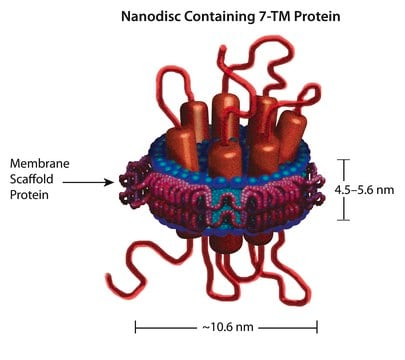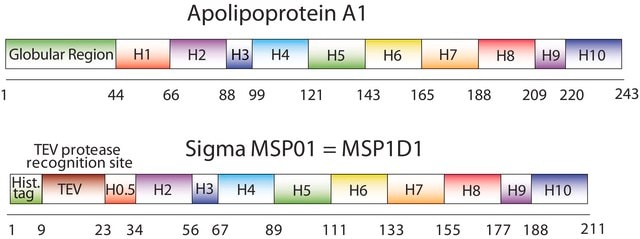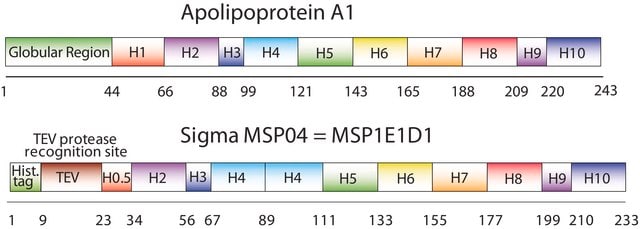MSP12
Membrane Scaffold Protein 2N2
recombinant, expressed in E. coli, MSP1D1-MSP1D2 fusion protein
Synonim(y):
Membrane scaffold protein
About This Item
Polecane produkty
rekombinowane
expressed in E. coli
Próba
≥90% (SDS-GE)
Postać
buffered aqueous solution
masa cząsteczkowa
45,541.2 Da
rozpuszczalność
water: soluble
Warunki transportu
ambient
temp. przechowywania
−20°C
Opis ogólny
The first MSP, MSP1, was engineered with its sequence based on the sequence of A-1 but without the globular N-terminal domain of native A-1. The Membrane Scaffold Protein 1D1 (MSP1D1) variant of MSP1 deletes the first 11 amino acids in the Helix 1 portion (referred to as “H0.5” in the accompanying figure) of the original MSP1 sequence. Membrane Scaffold Protein 2N2 (MSP 2N2) is a fusion of MSP1D1 and another MSP variant, MSP1D2. MSP1D2 deletes the first 22 amino acids of the original MSP sequence (i.e. the entire H1 segment). In MSP2N2, a GT linker connects MSP1D1 and MSP1D2.
Nanodisc technology is an approach rendering membrane proteins soluble in aqueous solutions in a native-like bilayer environment, where the membrane proteins remain stable and active. The Nanodisc concept is derived from high-density lipoprotein (HDL) particles and their primary protein component, apolipoprotein. The Nanodisc is a non-covalent structure of phospholipid bilayer and membrane scaffold protein (MSP), a genetically engineered protein that mimics the function of Apolipoprotein A-1 (ApoA-1).
Zastosowanie
Działania biochem./fizjol.
Informacje prawne
- 7,691,414 Membrane scaffold proteins
- 7,662,410 Membrane scaffold proteins and embedded membrane proteins
- 7,622,437 Tissue factor compositions and methods
- 7,592,008 Membrane scaffold proteins
- 7,575,763 Membrane scaffold proteins and tethered membrane proteins
- 7,083,958 Membrane scaffold proteins
- 7,048,949 Membrane scaffold proteins
Kod klasy składowania
12 - Non Combustible Liquids
Klasa zagrożenia wodnego (WGK)
WGK 2
Temperatura zapłonu (°F)
Not applicable
Temperatura zapłonu (°C)
Not applicable
Certyfikaty analizy (CoA)
Poszukaj Certyfikaty analizy (CoA), wpisując numer partii/serii produktów. Numery serii i partii można znaleźć na etykiecie produktu po słowach „seria” lub „partia”.
Masz już ten produkt?
Dokumenty związane z niedawno zakupionymi produktami zostały zamieszczone w Bibliotece dokumentów.
Klienci oglądali również te produkty
Protokoły
Nanodisc technology aids membrane protein solubilization, overcoming associated challenges in diverse protein classes.
Nasz zespół naukowców ma doświadczenie we wszystkich obszarach badań, w tym w naukach przyrodniczych, materiałoznawstwie, syntezie chemicznej, chromatografii, analityce i wielu innych dziedzinach.
Skontaktuj się z zespołem ds. pomocy technicznej











